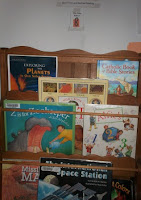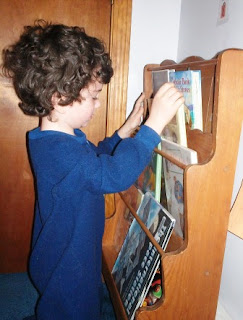The course aims to share some engaging children’s picture books that tie into value and faith themes and act as a springboard for design challenges.
During our first class, we read, Albert’s Alphabet
Here was the plan I used, first, in class, then, at home. (Luke and Nina have requested to “take Mommy’s class” at home each week after Co-op, so they can enjoy other teachers’ classes while co-op is in session.)
Materials Needed
To facilitate it My Friend Rabbit by Eric Rohamm and Building Towers to Point to Heaven, you will need:
- a copy of My Friend Rabbit
by Eric Rohmann
- a piece of paper for each child
- a paper clip for each child
- a magazine for each child or pair of child
- one sheet of address labels for each child or pair of child (These can be recycled from freebies you get in the mail; we were out of those, so I used blank labels.)
- scissors
Welcoming Prayer and Stretch
Welcome students back and ask if anyone can remember what we should do with our bodies to help our brains work. That’s right – stretch! Lead the following stretch, adding more movements than prior week:We thank you God for the sky above, (Stretch onto tip toes, arms up high, really reaching for the sky. Reach with one arm way up as high as you can. Reach with the other. Reach with both.)
and for the ground below. (Bend over and touch toes or floor. Tickle your own toes. Walk your hands up your ankles, calves, knees, thighs, tickling and/or squeezing your legs with your hands.)
We thank you, God, for everything (Lunge to one side, really stretching arm out. Press toward the wall.)
that we come to know. (Lunge to the other side. Then, feet together, Bend over and touch the ground again, Roll up. Stack kneed on top of feet, hips on top of knees, shoulders on top of hips, head up… Scrunch shoulders up to ear together. Then, one shoulder, the other, back to the first, back to the other. Up and down with both. Wiggle the entire body, turn around and sit down.)
Warm-Up Challenge: Make a Plane that Can Carry a Paperclip
Then, hand out one piece of paper to each child. Explain that for their mini-challenge of the day, they must create a plane that can carry a paper clip, just like the plane on the front of the book carries the mouse. They may not use any materials besides the paper and paper clip and may not use any tools besides their imaginations and bodies (hands).
Allow students to test and modify their planes, refolding them in ways to better carry the paperclip and noting some of the ways the flight patterns change depending on how the paperclips are placed on the planes.
Read Aloud: My Friend Rabbit
Congratulate students on their designs and let them know that we will now see what kind of flight the mouse on My Friend Rabbit goes on. Read My Friend Rabbit, asking students to read text that they are capable of and taking time to stop to really look at the pictures and to make predictions as you go, such as wondering what rabbit’s plan must be and trying to guess what he is pulling at first (an elephant!) or identifying what the problem is once he has all the animals stacked (they aren’t high enough) and predicting what he might do next, etc.
Also elicit how rabbit uses the same strategy we used last class to solve a problem. How? He identifies a problem (the plane in the tree), comes up with a plan and tests it (stacking all the animals to reach the plane), and, then, adapts the plan as necessary, before sharing the results.
Note how rabbit just goes ahead with his plan and tries it, while Albert from Albert’s Alphabet
Also, discuss other themes and values related the book—that we accept our friends for their good points and their more challenging ones. That problems can be solved. That teamwork can be helpful.
Further, identify and discuss how rabbit might solve the new problem presented by the final illustration in the book.
The Main Challenge: Building Towers to Point to God
 |
| Jack wants in on the building. |
Suggest that towers point toward Heaven. We should always reach toward Heaven and, through God’s grace will get there one day. Might we build a tower towards Heave, pointing to God, today, say, one as high as our belly buttons?
Present the challenge and its guidelines:
- We will build towers, individually or together, that point to God.
- They must be able to stand on their own.
- They must be made using only the materials (recycled magazines and sheets of address labels) and tools (scissors) provided.
 |
| Success! |
Have children pause occasionally to note each other’s ideas and talk about ones they might borrow from one another to adapt.
Notes
If you have extra time at the end of class, which I never seem to, try making other paper airplane designs, building towers from other materials or seeing if built towers can bear the weight of paper clips, paper airplanes, etc. Re-design towers as necessary to help them bear weight.- process over product
- experience and imagination over end-result and teacher-direction.
Honor the children’s problem solving abilities and the gift of creativity and personal interpretation that God grants each one of us.
He even invited a classmate to take her tower (below) to combine with his church. What a joy it was to see them working together at their own creation, employing gifts of problem-solving and teamwork!
Inspired by that student's invitation of collaboration, I request: If you happen to borrow ideas from this plan to use in your own home or co-op, please be sure to stop by and let me know how it went. I always enjoy collaborating to improve and adapt plans for future use.


























